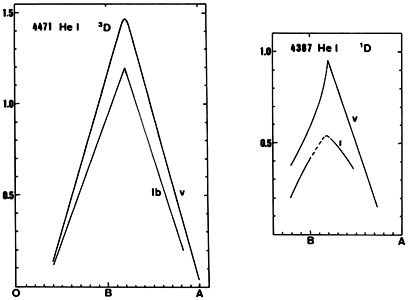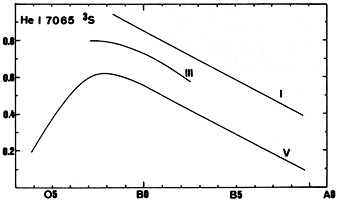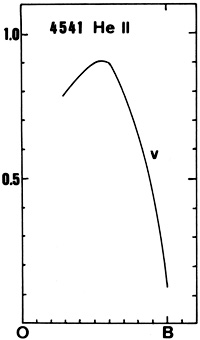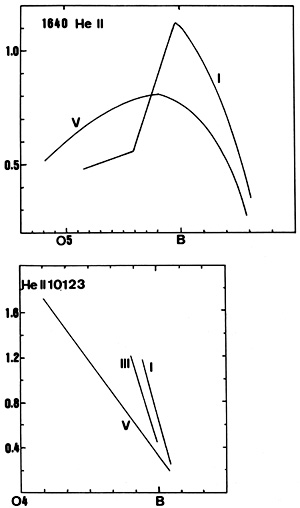
Ionization energies
HeI 24.6 eV, HeII 54.4 eV.
Absorption lines of HeI
| 4471(14) series 3D | 4387(51) series 1D | |||||
| Type | V | III | Ib | V | III | Ia |
| O3 | 0.20 | 0.13(f) | ||||
| O4 | 0.15 | 0.12 | ||||
| O6 | 0.4 | 0.40 | ||||
| O8 | 0.9 | 0.6 | 0.40 | 0.22(f) | ||
| O9 | 1.0 | 0.87 | 0.738 | |||
| B0 | 1.12 | 1.04 | 0.74(Ia) | 0.545 | 0.415 | |
| B0.5 | 0.73 | |||||
| B1 | 0.708(Ia) | |||||
| B2 | 1.47 | 1.13 | 1.20 | 0.95 | 0.74 | |
| B3 | 1.39 | 0.83(Ia) | 0.68 | 0.419 | ||
| B5 | 0.84 | 0.68 | 0.86 | 0.48 | 0.418 | |
| B6 | 0.75 | 0.61 | 0.59 | 0.23 | ||
| B7 | 0.48 | 0.35 | 0.185 | |||
| B8 | 0.45 | 0.22 | ||||
| B9 | 0.64 | 0.1 | ||||
| B9.5 | 0.145 | |||||
| A0 | 0.04 | |||||
Equivalent widths of He lines have also been published by Norris (1971).
He lines are used for discriminating the spectral type of the hot stars. If only He I is present, then the star is of type B; if He II is present, then the star is of type O. In the transition region at late O-type, He I and He II lines coexist. When He I lines disappear one has stars of spectral type A (or later).
Usually, for the determination of spectral type, one considers also the hydrogen lines, because hydrogen lines increase in strength monotonically from early O-type to A 2, where they have a maximum. Since both H and He lines are sufficiently strong to be easily measurable, the classification procedure can be carried out photometrically, using interference filters centered on selected He and H lines. For details of the procedures used in practice, see Golay (1974) and Jaschek and Jaschek (1987a). Another use of the photoelectric technique is to single out stars in which He lines are too strong or too weak for the temperature inferred from the H lines. In this sense Nissen (1974) used the 4026 line (18) of He I for singling out He-rich and He-poor stars.
| Group | V | III | Ia |
| O4 | 0.22 | ||
| O6 | 0.50 | ||
| O8 | 0.65 | 0.75 | |
| O9 | 0.60 | 0.74 | 0.92 |
| B0 | 0.58 | 0.74 | 0.86 |
| B2 | 0.42 | 0.60 | 0.74 |
| B5 | 0.27 | 0.60 | |
| B7 | 0.18 | 0.50 | |
| Source: The data are averaged from Jaschek and Jaschek, unpublished. | |||
For late type stars tmo He I lines, 10830(1) and 5876(11), have a considerable importance, since they are indicative of a stellar chromosphere (see Part Two, section 3.1).
 |
 |
Forbidden lines of HeI
Several forbidden lines of HeI, for instance 4469, 4025 and 4920 (Underhill
1966), are visible (only) in B-type dwarfs. If the rotation is sufficiently
low (and the plate factor of the spectrograms is adequate) the forbidden
lines can be separated from the permitted nearby He I lines.
Emission lines of HeI
Some HeI lines are present in emission in Oe stars
(Conti and Leep 1974, Frost and Conti 1976, Andrillat et al. 1982). The
10830(1) line is in emission in most O-type stars outside the main
sequence.
The emissions are strong (up to 46 Å) and variable in time (Andrillat
and Vreux 1979). In the later subtypes of WN stars HeI 6678(46) and
7065(10) are present in emission, the former being the stronger, with
W up to 60 Å(Conti et al. 1990). No HeI in emission has been
observed in the ultraviolet (Nussbaumer et al. 1982, Willis et al. 1986).
Eenens et al. (1991) recently found a number of strong He I emission lines in the infrared region (1 - 3µm) of WC stars.
One finds HeI in emission in some B[e] stars (Ciatti et al. 1974), in high luminosity stars (McGregor et al. 1988) and in T Tau stars (Schneeberger et al. 1978).
He I lines are seen in emission in RV Tau and W Vir stars; they are absent in RR Lyr, Cetheids and Miras (Gillet 1988). In long-period variable stars, 10830 is usually in emission around the light maximum (Querci 1986); 5876 and 6678 appear in emission in the so-called dMe stars (see the discussion on hydrogen emission lines, p. 79).
Symbiotic objects often exhibit HeI in emission (Baratta et al. 1991, Freitas, Pacheco and Costa 1992). The same is true for R CrB stars (Merrill 1951b, Cottrell and Lambert 1982) and in novae (Hyland 1974). In symbiotic stars W(2.0581µm) can be as high as 30 Å (Schild et al. 1992).
He I 10830 has also been observed in emission in all those S-type stars that do not exhibit Tc Johnson 1992).
Absorption lines of HeII
| 1640(12) | 4200(3) | 10123(2) | |||||
| Group | V | I | V | I | V | III | Ia |
| O4 | 0.50(f) | ||||||
| O5 | 0.50 | 1.72 | |||||
| O6 | 0.50(f) | ||||||
| O7 | 0.68 | 0.42 | 1.24 | ||||
| O8 | 0.78 | 0.55 | 0.50 | 0.40(f) | 0.80 | ||
| O9 | 0.80 | 0.85 | |||||
| O9.5 | 0.25 | 1.10 | |||||
| B0 | 0.75 | 1.15 | 0.31 | 0.42 | 0.41 | ||
| B0.5 | 0.27 | ||||||
| B1 | 0.68 | 0.95 | |||||
| B2 | 0.50 | 0.70 | |||||
| B3 | 0.25 | 0.40 | |||||
| Source: Values for 1640 averaged for MK standards are from Prinja (1990). Values for 10 123 are from Jaschek et al., unpublished. | |||||||
| Type | V | Ia |
| O3 | 0.79 | 0.74(f) |
| O4 | 0.8 | |
| O5 | 0.9 | |
| O6 | 0.9 | |
| O7 | 0.8 | |
| O8 | 0.6 | |
| O9 | 0.4 | |
| B0 | 0.2 | 0.145 |
He II lines are only visible in spectral type O, except 1640, which is also seen in early B-type stars. HeII lines have a positive luminosity effect, except 1640, which shows a negative luminosity effect before O 8.
 |
Emission lines of HeII
An O-type star that shows NIII (4630-34) in emission and also exhibits HeII
4686 in emission is called an Of star. When 4686 appears as a
fill-in,
the star is classified O(f) and when it is an absorption line,
O((f)) (Walborn 1973).
In WN stars 5411(2) is in strong emission, with 4 < W < 70 Å(Conti and Massey 1989), as also is 4686, with 1O < W < 150 Å. In the infrared region WN stars exhibit 6683, 6891, 8237 and 10123 in emission, the latter being the most intense (W up to 380 Å). In WC stars 4686 is probably present in emission but strongly blended with CIII 4650 and CIV 4658 (Conti and Massey 1989). In the infrared 10123 is seen in strong emission in all subtypes except the latest (W up to 270 Å) (Conti et al. 1990). For detailed measurements of the infrared helium emission features, see Vreux et al. (1990).
In WN stars one also sees in emission the ultraviolet lines 1640 (W up to 160 Å), 2252, 2306, 2511 and 2733, whereas in WC stars there appear only 1640 and 2733 (W up to 60 Å) (Nussbaumer et al. 1982, Willis et al. 1986). In the infrared Eenens et al. (1991) recently detected the line at 1.344 µm.
The HeII line 1640 appears sometimes in late type stars in emission. Its appearance indicates the existence of a stellar chromosphere. The line is visible in G and K dwarfs, and disappears in M-type dwarfs. See the discussion on chromospheres.
He II 4686 is always seen in emission from symbiotic stars (Allen 1988) and is sometimes accompanied by other lines of the same species (Baratta et al. 1991, Freitas, Pacheco and Costa 1992).
 |
Behavior in non-normal stars
He is very strong in the so-called He-strong stars, also
designated as extreme helium stars or hydrogen-deficient
stars. In the extreme
cases, He substitutes completely for the hydrogen. In less extreme
cases, He
lines coexist with hydrogen lines in the spectrum. Stars of such kind exist
in both populations I and II. In population II the sdO
(Baschek et al. 1982) and sdB (Baschek and Norris 1970) stars may be
He-rich. In such cases, anomalies are present in the behavior of the
different He series. In the He-rich sdO stars, there exist
differences in the behavior of the lines of the 2F and
2G series. In these stars
carbon and nitrogen are also enhanced (Rauch et al. 1991).
In sdB stars one finds anomalous relations between the line strengths of the singlet and triplet series of He I. For details see Jaschek and Jaschek (1987a) and for a theoretical explanation see Baschek and Norris (1970).
He is very strong in some of the central stars of planetary nebulae of the so-called H-deficient class (Mendez 1991). He is also very strong in hot extreme helium stars( Jeffery and Heber 1993) and in the spectra of pre-degenerates (Werner et al. 1991), although one pre-degenerate is known that has neither He nor H (Werner 1991).
He is weak in a number of stars that are called 'helium-weak' and such stars are present in both populations I and II. In population I for instance all Bp stars of the subgroups Hg-Mn and Si are He weak. In the latter group W(4026) is weaker by a factor 2 - 6 (Deutsch 1956).
In the N-variety of the CNO stars, also called OBN stars by some authors (Schoenberner et al. 1988), He I lines are slightly stronger than in normal stars of the same spectral type.
He is weak in HB stars, with varying degrees of weakness (Heber 1991) ranging from moderate weakening to almost complete disappearance.
He lines are very strong in the so-called DB stars and for some years it was almost a dogma that besides He no other elements are visible in the spectra of these stars. However, recently the number of exceptions has become rather large - in many stars one sees Ca lines (Sion et al. 1988) and in 20% of all DB stars one also sees (faint) hydrogen lines (Shipman et al. 1987), see also Weidemann and Koester (1991).
He lines are very weak or absent (W < 0.1) in DZ stars (Sion et al. 1990).
In symbiotic stars, both HeI and HeII lines are often seen in emission (see above).
In novae HeI absorption lines are enhanced in the 'Orion spectrum' phase. Emission lines of HeII are seen in the ultraviolet spectral region during the principal spectrum phase (Warner 1989). He I and He II emissions are also seen in nova remnants. In particular, 4686 of HeII appears in many classical and recurrent novae but is weak or absent in dwarf novae (Warner 1989).
He lines are absent in the spectra of supernovae of Class Ia, they are very strong in those of class Ib and present in those of class II (Branch 1990).
Isotopes
He has three stable isotopes, namely He 3, 4 and 5, and two short-lived
ones.
In the solar system and also in the sun, only the first two are present and
the He3 / He4 ratio is very small
(10-4). The best way to
investigate the presence of He3 is to use the isotopic
shifts. The most
favorable case in the visual red region is He I 6678, where the shift is
about 0.50 Å. For other HeI lines like for instance 5875 the shift
is much smaller (0.04). In the infrared, the He I 10830 line has an
isotopic shift of 1.15 Å(Zirin 1968).
The first star in which He3 was detected was an early type Bp star (Sargent and Jugaku 1961). Hartoog and Cowley (1979) studied a large number of early type stars and give a list of eight secure and four possible or probable stars with a large fraction of He in the form of He3. Afterwards several HB and sdO stars were discovered in which He is predominantly in the form of He3. However, this does not apply to all stars of these groups (Heber 1991).
Origin
He was either produced by cosmological nucleosynthesis at the beginning of
the universe or later by hydrogen burning.
Published in "The Behavior of Chemical Elements in Stars", Carlos Jaschek and Mercedes Jaschek, 1995, Cambridge University Press.